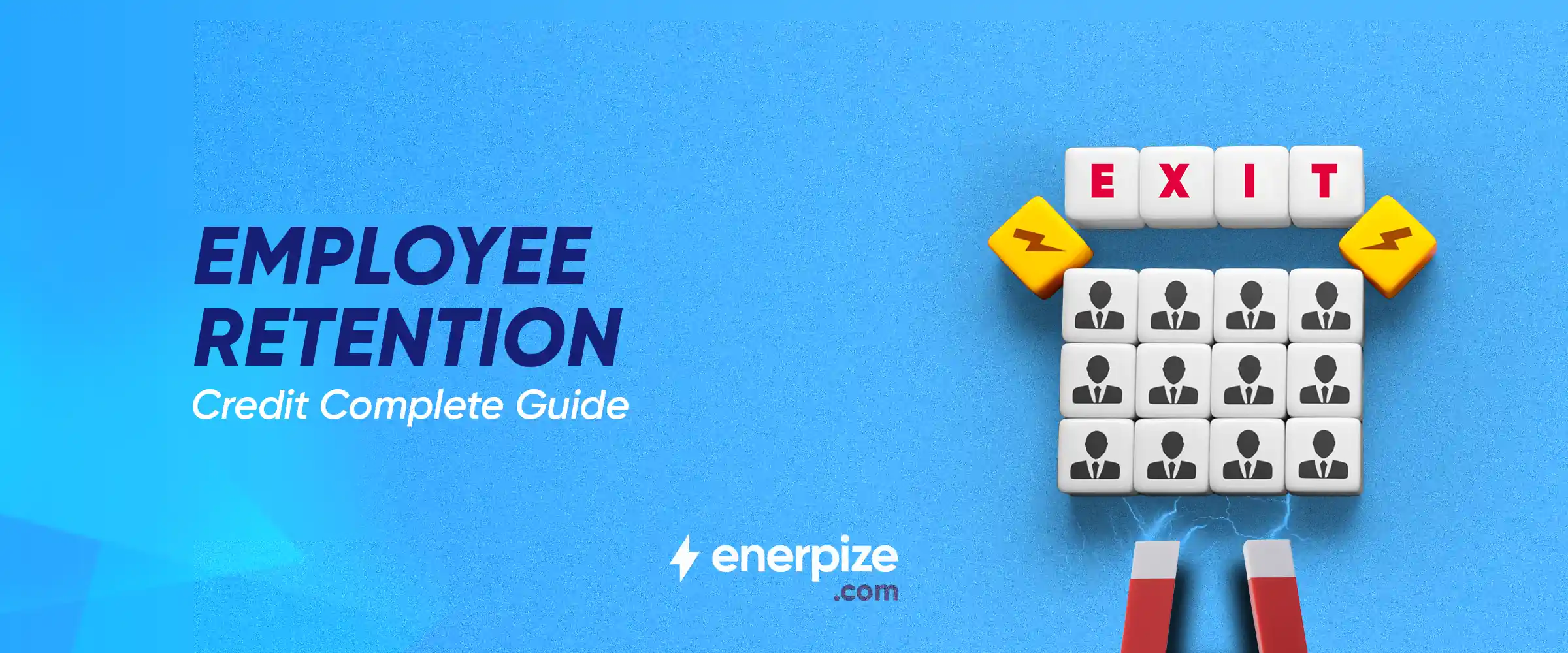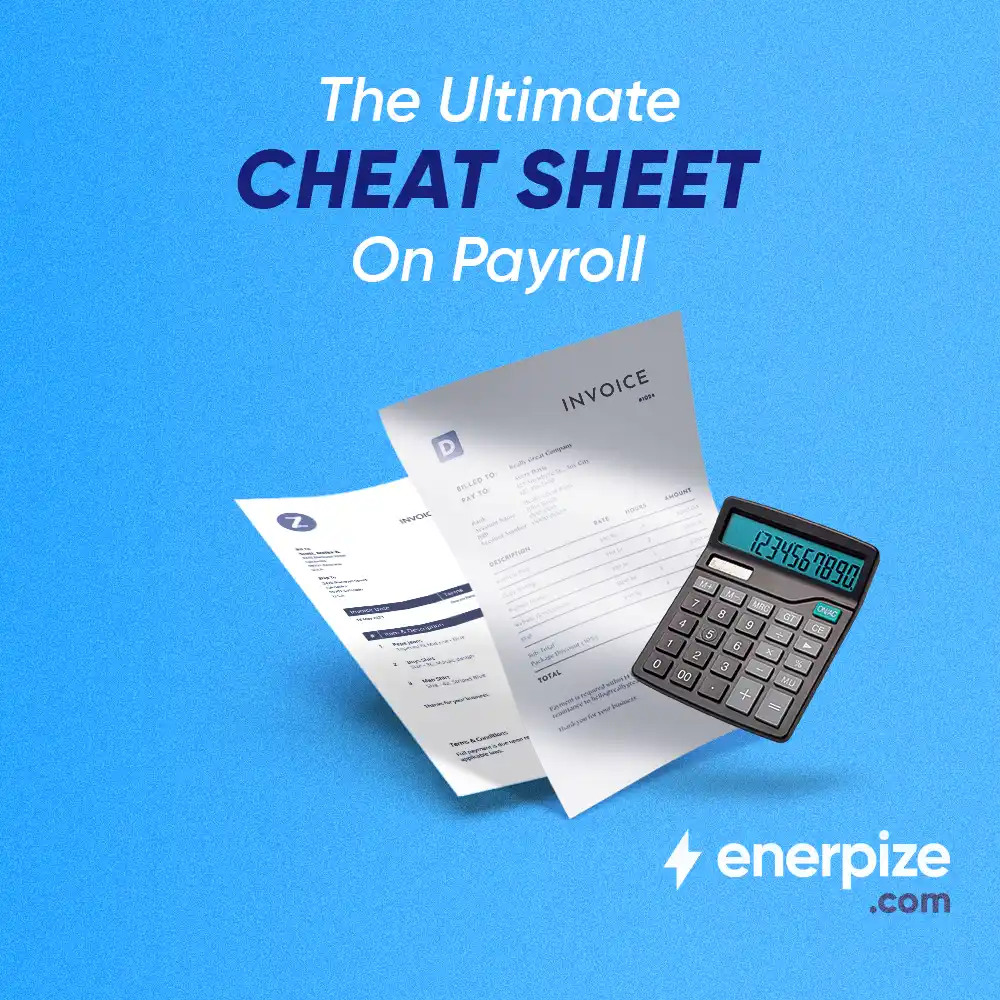Author : Haya Assem
Reviewed By : Enerpize Team
Employee Retention Credit (ERC): A Complete Guide

Table of contents:
- What is an employee retention credit worksheet?
- Advantages of Employee Retention Credit worksheet
- How to calculate employee retention credit worksheet
- What are the two ways to be eligible for ERC?
- How to apply for Employee Retention Credit in 6 steps
- How to claim the ERC
- How does employee retention credit affect tax returns?
- Final thoughts
COVID-19 has caused numerous companies to lay off staff, close their doors, or be wholly or partially suspended by official COVID-19 orders, resulting in significant losses for many small businesses.
This was a strong motive for the U.S. government to move toward the general interests of residents and the state's economy, therefore the U.S. government offered certain solutions to business owners, the most prominent of which was the Employee Retention Credit (ERC).
After confirming eligibility, the government provided a credit of up to $28,000 per employee to compensate businesses affected by significant revenue losses or disruptions due to the COVID-19 consequences, which led to the partial or complete liquidation of several companies in 2020.
Once you've determined that your company meets the requirements for the ERC, the next step is to figure out how to calculate it, and you'll need the employee retention credit worksheet to do so.
In this article, we'll go over the employee retention credit in further detail, including the advantages, how to apply, qualifications, how to calculate it, and all the details you need to know.
Key Takeaways
- You can receive up to $28,000 per employee through the ERC if your business experienced partial closure or significant revenue decline due to COVID-19, making it a vital relief option.
- You’ll use the ERC worksheet to calculate your eligible credit by entering details like qualifying wages and full-time employee counts, ensuring accuracy and compliance.
- You must meet eligibility criteria, which vary between 2020 and 2021, based on factors like the number of employees, revenue loss, business suspension, and startup status.
- You need to identify qualifying quarters, document closure or loss of gross receipts, and determine eligible employees and wages to properly calculate your ERC.
- You can apply for the ERC by evaluating your eligibility, gathering business data, calculating qualified wages, and filing the appropriate IRS forms, such as Form 941 or 941-X.
- You’ll benefit from automation in tracking wages and employee statuses, and by claiming the credit, you reduce federal tax liabilities or potentially receive a refund.
- You should know the ERC affects your tax returns by reducing what you owe in federal employment taxes and possibly providing excess credit as cash back to support your business.
What is an employee retention credit worksheet?
The Employee Retention Credit (ERC) worksheet is a tool that helps companies determine the amount of credit they're eligible to claim through the Employee Retention Credit program.
This worksheet normally includes extensive sections in which companies enter necessary details such as qualifying wages, the number of full-time employees, and other government-specified requirements.
Businesses must carefully follow the directions provided in the ERC worksheet to guarantee appropriate calculations. The worksheet is essential for claiming the credit accurately and capturing the relevant information for tax reasons.
It is a useful tool for companies to deal with the complexity of the Employee Retention Credit procedure and assures compliance with government regulations.
Advantages of Employee Retention Credit worksheet
The ERC worksheet provides several advantages to companies navigating the process of claiming this tax credit:
Calculation accuracy
The main purpose and advantage of the Employee Retention credit worksheet is to help companies achieve a hassle-free accurate calculation procedure. It helps businesses determine the amount eligible depending on several factors such as qualifying wages and the number of full-time employees.
Compliance
The worksheet is prepared in compliance with government regulations and standards, ensuring that companies meet the ERC eligibility criteria and follow all laws and guidelines.
Clarity
ERC worksheets often offer clear instructions and information on eligibility criteria that help employers understand their company's state and if it is eligible for the ERC.
Documentation
The worksheet provides a systematic method for documenting the information required to claim the credit. This worksheet is critical for proving the credit claim during tax audits or tax authority reviews.
How to calculate employee retention credit worksheet
The Employee Retention Credit (ERC) must be calculated by identifying several details such as qualified wages and the eligible employer's part of the credit. The following steps are usually included in the process:
Identify eligible employees and periods
Determine whether employees are eligible for the ERC and those specific periods for which qualified expenses and wages are paid and the credit is calculated. Those periods are:
- 2020
Q2 March 13 – June 30, 2020
Q3 July 1 – September 30, 2020
Q4 October 1 – December 31, 2020
- 2021
Q1 January 1 – Match 31, 2021
Q2 April 1 – June 30, 2021
Q3 July 1 – September 30, 2021
The fourth quarter is intended for small businesses in recovery: 1 October to 31 December 2021
ERC eligibility
Note that all employers don’t qualify for the ERC, various qualifications differ from 2020 to 2021. The following are the 2020 qualifications:
- Employers must have 500 or fewer full-time W-2 employees in the stated quarter.
- The company should be in operation before February 16, 2020.
- Business must be suspended completely or partially due to a government order.
- The company must have lost at least 50% of gross receipts during the qualifying quarter when compared to the same calendar quarter in 2019.
While the qualifications for 2021 are nearly identical to those for 2020, there is little variation in the loss of gross receipts, which must be at least 20% to qualify for the employee retention tax credits for a qualifying quarter compared to 2019.
Determine potential qualifying closure
Determine if your company went through a complete or partial suspension owing to government orders or a significant drop in gross receipts compared to the previous year.
Consider the calendar quarters in question, make sure your company has 500 or fewer employees in the qualifying quarter, and check IRS standards for the most up-to-date information.
Documentation establishing eligibility, such as government directives and financial records, is essential, and getting expert guidance in difficult instances is recommended.
Business status
Check to see if your company is a recovery startup since this might be your key to ERC eligibility. Recovery startups are those that began operations after February 15, 2020, and have gross receipts of less than $1 million.
Review qualified wages for each year
Include qualifying expenses and wages for workers' health plans throughout their eligibility period. This is the period during which the company was either closed or substantially influenced the gross receipts.
For larger employers, limit qualified wages to payments made to employees who did not provide services during the relevant period.
Calculate Employee Retention Credit
In 2020, the qualifying wage limit was $10,000 per employee per year, and employers could claim up to 50% of that amount, resulting in a total ERC of $5,000 per employee for the year.
In 2021, the limit on eligible wages is $10,000 for each full-time employee per quarter rather than per year, and companies can now take up to 70% of those wages. This means that the total ERC employers can claim is $7,000 per employee per quarter or $21,000 per employee per year.
What are the two ways to be eligible for ERC?
Exploring the criteria for eligibility for the Employee Retention Credit (ERC), two basic routes emerge: company suspension or shutdown owing to government orders and a significant decline in gross receipts.
Suspension or shutdown of a business
If a company's operations have been suspended whole or partially owing to COVID-19-related government orders. This might include non-essential company closures or limitations that have a major impact on operations.
Gross receipts decline
If a company's gross receipts fell significantly from the same quarter the previous year. In general, a decline of 50% or more in gross receipts qualifies a business for the ERC.
Employee Retention Credit example
A company that had 150 full-time employees in 2019. Due to pandemic-related restrictions, the company was partially suspended by a government order in the second quarter of 2020.
The company experienced a significant decline in gross receipts, with a 60% reduction in the second quarter of 2020 compared to the same quarter in 2019.
ERC calculation for the company
Determine Eligible Quarters: Due to the partial suspension and large decline in gross receipts, the company qualifies for the ERC in the second and third quarters of 2020.
Calculation of Qualified Wages: For each eligible employee the employer can claim 50% of up to $10,000 paid across all quarters – so, the business can claim $5,000 per employee per year, totaling $100,000.
Filing and claiming the credit
The company can claim the ERC for the qualified quarters when submitting its employment tax returns (Form 941).
If the ERC exceeds the total federal employment taxes owing for those quarters, the company can receive the excess amount as a refund.
How to apply for Employee Retention Credit in 6 steps
Evaluate the company’s eligibility
Examine the qualifying requirements, considering issues such as company suspension or a significant decline in gross receipts. Check to see whether your company meets the IRS's requirements.
Gather necessary data
Start by acquiring all of your company's data. Consider everything relevant to the company, such as:
- Legal company name
- Details and legal address
- Documentation of eligible wages
- Number of full-time employees
- Evidence of business suspension or gross receipts decline
File and claim refundable credits
Recognize that the ERC is refundable, which means that if the credit exceeds the total amount owing in federal employment taxes, the excess can be refunded. This aspect may help qualifying businesses receive financial assistance.
After you've filed your claim, expect to wait a while before a refund is (hopefully) applied — as always, you'll have to wait for the IRS.
Qualified wages
Understanding the IRS criteria for calculating qualifying wages for the Employee Retention Credit (ERC) is required. The calculation method might differ depending on the size of the employer and specific circumstances.
Employers with less than 100 full-time employees
- Include all wages
- All wages provided to employees, regardless of whether they worked during the relevant time, are considered qualified wages.
Employers with over 100 full-time employees
- Limit to Non-Working Employees
- In general, qualified wages are payments provided to employees who did not offer services during the relevant time.
Fill out IRS forms
Depending on the tax year, you may be required to fill out particular forms in order to claim the ERC. Employers, for example, often use Form 941, Employer's Quarterly Federal Tax Return, to record wages and claim the credit.
File all required tax forms
When completing your quarterly or yearly employment tax forms with the IRS, include the ERC information. Maintain accurate reporting and strict adherence to deadlines.
How to claim the ERC
Eligible businesses that did not claim the Employee Retention Credit (ERC) on their original employment tax return can file amended employment tax returns. For example, businesses submitting quarterly employment tax returns, such as Form 941, can use Form 941-X to claim the credit for the applicable quarters.
Employers may choose to retain the value of employment taxes, up to the amount of the ERC, before depositing it, without incurring penalties. This is known as the "retention" option, allowing businesses to access the funds more quickly.
How does employee retention credit affect tax returns?
You can claim your ERC on your federal employment tax returns. This typically refers to your quarterly federal tax return 941. If you qualify for ERC and didn’t know it before, don’t worry. You can amend your form for your federal tax return 941. The ERC directly reduces the amount of federal employment taxes that a business owes. If the credit exceeds the tax liability, the excess can be refundable, providing a potential cash benefit to the business.
Final thoughts
In response to the economic challenges posed by COVID-19, the U.S. government established the Employee Retention Credit (ERC) as a critical corporate remedy. This credit, amounting to $28,000 per employee, aims to compensate businesses affected by the pandemic's consequences.
Businesses may use the ERC worksheet to calculate the ERC correctly, guaranteeing compliance with regulatory rules. The worksheet provides benefits such as calculation accuracy, guarantee of compliance, clarity, and systematic recording. Detailed steps for ERC calculation, eligibility criteria, and application processes are outlined, emphasizing the credit's positive impact on tax returns and potential refundability.
Employee Management is easy with Enerpize.
Try our HR module to manage your employees





